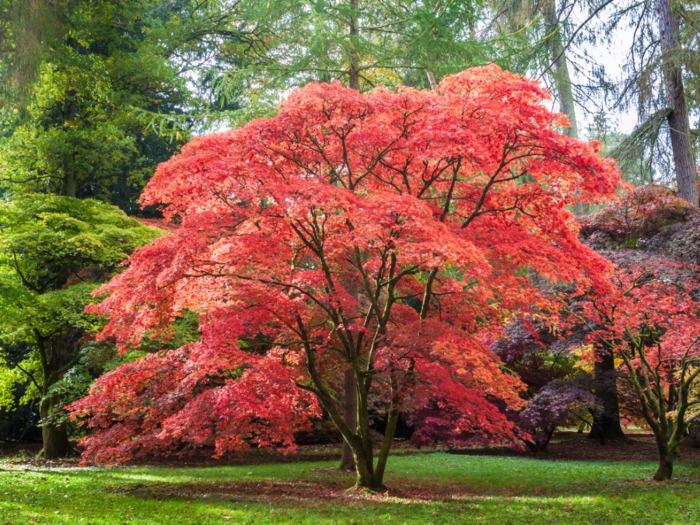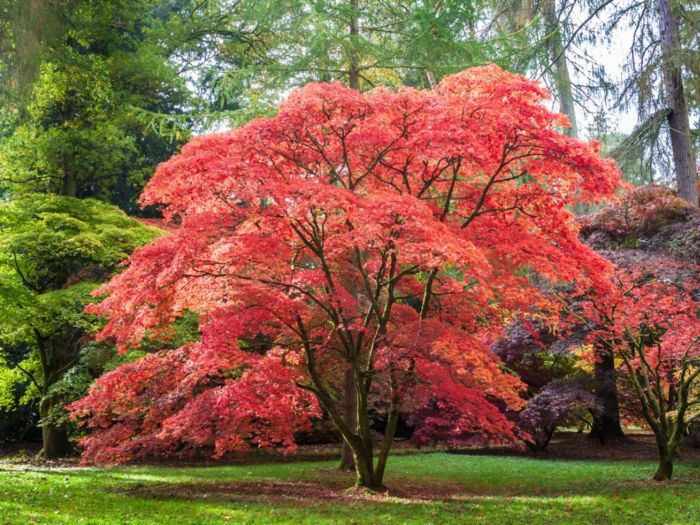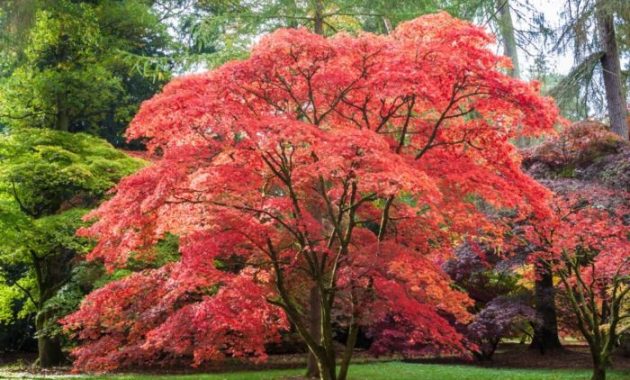Choosing the Right Japanese Maple Tree

Plant japanese maple tree – Selecting the perfect Japanese Maple for your garden requires careful consideration of several factors. The right cultivar can transform your landscape, adding elegance and vibrant color, while the wrong choice can lead to disappointment. Understanding the key characteristics of different varieties, their ideal growing conditions, and the nuances of their root systems is crucial for long-term success. This will ensure your Japanese Maple thrives and becomes a cherished centerpiece of your outdoor space.
Japanese Maple Cultivar Comparison
Choosing the right Japanese Maple cultivar depends largely on the available space, the amount of sunlight your garden receives, and your desired aesthetic. Below is a comparison of four popular cultivars, highlighting key differences to aid in your selection process. Remember, these are approximate mature sizes and can vary based on growing conditions.
| Cultivar | Mature Size (H x W) | Leaf Color | Sun Tolerance |
|---|---|---|---|
| Acer palmatum ‘Bloodgood’ | 15-25 ft x 10-20 ft | Deep red, almost black | Partial shade to full sun (morning sun preferred) |
| Acer palmatum ‘Dissectum’ (e.g., ‘Crimson Queen’) | 8-15 ft x 8-15 ft | Deep red (Crimson Queen) to various shades of green and red depending on the specific cultivar | Partial shade |
| Acer palmatum ‘Osakazuki’ | 20-30 ft x 15-25 ft | Green in summer, brilliant scarlet in autumn | Partial shade to full sun |
| Acer palmatum ‘Shishigashira’ (Lion’s Head) | 6-8 ft x 6-8 ft | Green in summer | Partial shade |
Ideal Soil Conditions for Japanese Maples
Japanese Maples thrive in well-drained, slightly acidic soil (pH 6.0-6.5). Poor drainage is a major cause of root rot, a common problem leading to the decline and death of these trees. The soil should be rich in organic matter, which improves water retention and provides essential nutrients. Amend heavy clay soils with compost or other organic materials to improve drainage and aeration.
Yo, planting a Japanese Maple? It’s all about the right soil, bro. Similar vibes to planting other fruit trees, like, you know, check out this guide on how to plant nectarine tree for some solid tips on prepping the ground. Then, just adapt those techniques for your Japanese Maple and you’re good to go, fam.
Easy peasy, lemon squeezy!
Conversely, sandy soils may require the addition of organic matter to increase water retention. Regular soil testing can help you maintain the optimal pH level and nutrient balance. Consider using a soil moisture meter to monitor moisture levels and prevent both overwatering and underwatering.
Understanding Japanese Maple Root Systems and Their Impact on Planting and Transplanting
Japanese Maples have a relatively shallow, fibrous root system. This means their roots spread horizontally near the soil surface rather than penetrating deeply. This characteristic is crucial to consider when planting and transplanting. Because of this shallow root system, they are susceptible to damage during transplantation, especially larger, more established trees. Smaller trees are generally easier to transplant successfully.
When planting, avoid disturbing the roots unnecessarily. Choose a location with ample space to accommodate the mature size of the tree, and avoid planting too deeply. Properly preparing the planting hole and amending the soil with organic matter are key to successful establishment. When transplanting, consider using a root ball to minimize root damage. The smaller the root ball, the easier it will be for the tree to recover from the transplant shock.
Planting Your Japanese Maple
Planting a Japanese Maple correctly is crucial for its long-term health and vibrant growth. A well-executed planting process sets the stage for years of stunning autumn color and elegant form. Neglecting proper planting techniques can lead to stunted growth, disease susceptibility, and even death. Let’s ensure your Japanese Maple thrives.
Proper planting involves several key steps, from site selection and hole preparation to watering and ongoing care. Following these steps will significantly increase your chances of success.
Hole Preparation and Placement
Before you even think about placing your Japanese Maple in the ground, meticulous preparation is key. The size and location of the planting hole directly impact the tree’s ability to establish a strong root system. Digging a hole that’s too small restricts root growth, while a hole that’s too large can lead to instability and desiccation.
- Digging the Hole: The hole should be at least twice as wide as the root ball of your Japanese Maple. The depth should be such that the top of the root ball sits level with the surrounding ground. Avoid planting too deeply, as this can suffocate the roots.
- Choosing the Right Spot: Japanese Maples prefer partial shade, especially in hotter climates. They need protection from harsh afternoon sun. Consider the mature size of the tree and ensure it has ample space to grow without overcrowding.
- Soil Amendment (Optional): If your soil is heavy clay or poorly draining, amend the backfill soil with organic matter like compost. This improves drainage and aeration, which is crucial for healthy root development. A 50/50 mix of native soil and compost is a good starting point.
Planting and Backfilling
The act of planting the tree and backfilling the hole is delicate. Careless handling can damage the roots, hindering establishment. Gentle handling and proper backfilling techniques are essential for a successful planting.
- Gently Remove the Tree from its Container: Carefully remove the tree from its container, being mindful not to damage the roots. If the roots are circling (root-bound), gently loosen them before planting.
- Place the Tree in the Hole: Position the tree in the center of the hole, ensuring the top of the root ball is level with the surrounding ground. Check this carefully using a level.
- Backfill the Hole: Gradually backfill the hole with the prepared soil, ensuring there are no large air pockets. Firm the soil gently around the root ball to eliminate air gaps but avoid compacting it too tightly.
- Create a Water Basin: Form a small basin around the base of the tree to help retain water during the initial watering.
Proper Depth and Spacing for Multiple Japanese Maples
Visualize a diagram showing several Japanese Maples planted in a row. Each tree is planted at the same depth, with the top of its root ball level with the surrounding ground. The distance between each tree’s center is at least 1.5 to 2 times the mature width of the tree, depending on the variety. For example, if a mature tree will reach 10 feet wide, you’d want to space them at least 15 to 20 feet apart.
This ensures that the trees have adequate space to develop their canopies without competing for resources. The diagram would show the root systems of each tree, demonstrating that they do not overlap significantly. This spacing prevents overcrowding and promotes optimal growth for each individual tree.
Immediate Watering and Subsequent Watering Schedule, Plant japanese maple tree
Watering immediately after planting is critical for shock prevention. The first month’s watering schedule is crucial for establishing a robust root system. Insufficient watering can lead to wilting and even death.
Water deeply and thoroughly immediately after planting, ensuring the soil is completely saturated. For the first month, water deeply once or twice a week, depending on rainfall and weather conditions. Check the soil moisture regularly; if the top inch or two feels dry, it’s time to water again. Avoid overwatering, as this can lead to root rot.
A consistent watering schedule will ensure the tree establishes itself successfully.
Troubleshooting Common Problems

Even with meticulous care, Japanese maples can encounter challenges. Understanding these issues and implementing proactive solutions is crucial for maintaining their vibrant health and longevity. Addressing problems promptly can prevent minor setbacks from escalating into significant damage. This section Artikels common problems, their causes, and effective solutions.
Leaf Scorch
Leaf scorch manifests as browning and crisping of leaf margins, progressing inward. This is often a sign of insufficient water uptake, particularly during hot, dry periods. Several factors contribute to leaf scorch. These include inadequate watering, particularly during establishment, and environmental stressors like intense sun exposure and wind. Soil compaction, which restricts root growth and water absorption, is another major culprit.
Improper planting depth, placing the root flare too deep, can also hinder water uptake.
| Problem | Causes | Solutions |
|---|---|---|
| Leaf Scorch | Insufficient watering, intense sun exposure, wind, soil compaction, improper planting depth | Consistent watering, especially during dry spells; providing afternoon shade; windbreaks; amending soil with organic matter to improve drainage and aeration; ensuring correct planting depth. |
Chlorosis
Chlorosis presents as yellowing of leaves, often between the veins, indicating a nutrient deficiency, most commonly iron. Alkaline soil conditions (high pH) frequently hinder iron uptake, leading to chlorosis. Overwatering can also contribute by reducing oxygen availability to roots, impacting nutrient absorption. Furthermore, poor soil drainage prevents efficient nutrient delivery.
| Problem | Causes | Solutions |
|---|---|---|
| Chlorosis | Iron deficiency (often due to high soil pH), overwatering, poor soil drainage | Soil testing to determine pH; application of iron chelates (a readily available form of iron); improving soil drainage; adjusting watering practices to avoid overwatering. |
Root Rot
Root rot, caused by fungal pathogens thriving in consistently wet, poorly drained soil, is a serious threat. Symptoms include wilting, leaf drop, and overall decline. Poor air circulation around the roots, often stemming from compacted soil or overwatering, creates an ideal environment for these fungi to proliferate.
| Problem | Causes | Solutions |
|---|---|---|
| Root Rot | Poorly drained soil, overwatering, compacted soil | Improving soil drainage by amending with organic matter; adjusting watering practices; avoiding overhead watering; in severe cases, removing affected roots and replanting in well-drained soil. |
The Importance of Proper Soil Drainage
Proper soil drainage is paramount for the health of Japanese maples. Well-drained soil allows for efficient water uptake and prevents waterlogging, which suffocates roots and creates conditions favorable for fungal diseases like root rot. Adding organic matter like compost improves soil structure, increasing aeration and drainage. This ensures that roots receive adequate oxygen and nutrients while preventing water stagnation.
Poor drainage can lead to a cascade of problems, including chlorosis, leaf scorch, and ultimately, tree death. Investing time and effort in ensuring excellent soil drainage is a crucial preventative measure against many common Japanese maple ailments.
Answers to Common Questions: Plant Japanese Maple Tree
What is the best time of year to plant a Japanese Maple?
Early spring or fall, when the ground is workable and temperatures are moderate, is ideal. Avoid planting during periods of extreme heat or frost.
How often should I fertilize my Japanese Maple?
A slow-release fertilizer applied once in early spring is usually sufficient. Over-fertilizing can be harmful.
My Japanese Maple leaves are turning brown. What should I do?
Brown leaves can indicate several problems, including sun scorch, insufficient watering, or pests. Inspect the tree carefully and address the underlying cause.
Can I prune my Japanese Maple heavily?
Heavy pruning is generally discouraged. Light pruning to remove dead or damaged branches is acceptable, but avoid drastic cuts.
How do I protect my Japanese Maple from deer?
Deer can damage young Japanese Maples. Use deer repellent sprays or physical barriers like fencing to protect them.

